14 Facebook Marketing Goals for 2014
JANUARY 7, 2014 BY
As the new year rolls out, it’s important to do some planning and establish some goals.
I’ve seen that the biggest reason more people aren’t successful with Facebook marketing is that they simply don’t know everything that’s available to them. As a result, I’ve put together the following list of 14 goals to get you started on a successful 2014.
Keep experimenting, my friend!
1. Share More Frequently
Back in the day, we were told not to post too often or risk annoying our fans. We were told to post a few times per week, but usually no more than once — maybe twice — per day.
Because of this, the importance of the success of each individual post was very high. It’s a big reason why we started obsessing over the Reach metric.
The truth is that the rules of posting less frequently no longer apply. Your fans aren’t online every day and most won’t be on when you post. So it’s completely acceptable to post throughout the day.
I personally have a strategy that includes posting my most recent blog post in the morning, sharing content from others and random tidbits in the afternoon, and thenresharing evergreen content at night.
The result? I reach more unique people over a given day and drive more traffic to my website.
Your Goal for 2014: Establish a posting strategy that involves posting at times you wouldn’t normally post. Block off a time of day specifically for evergreen content, for example, and begin scheduling those posts in bulk (I use PostPlanner for this). Then compare your results to when you posted less frequently.
2. Establish a Facebook Sales Funnel
One mistake marketers make is that they think they can show up on Facebook and get sales. Or create ads without establishing an audience and drive volumes of revenue.
Sure, you can generate sales without an active Facebook page. And you can even get sales from non-Fans.
But you know what? It works a whole lot better if you focus on generating the relevant audience first. Sales are much more likely to come from organic and paid posts to people who know and trust you through regular, valuable content.
Your Goal for 2014: Read this post and then establish your own Facebook sales funnel!
3. Target Email Subscribers With Link Shares
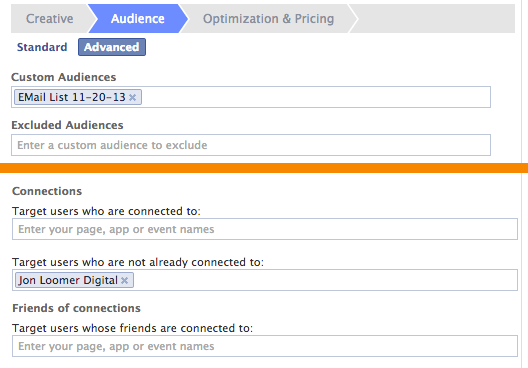
Every time I share a new blog post with my Fans, I promote it with a Facebook campaign. That campaign includes two ads: One that is targeted at my fans and another targeted at my email subscribers who aren’t fans.
I do this to reach as many people as possible who would be most likely to want to read that blog post. The goal here is to increase website traffic, and if you focus only on fans, you’re forgetting a valuable group!
Your Goal for 2014: Create a Custom Audience for your entire email list. Target that list, and make sure you are excluding anyone who is already a fan of your page.
4. Retarget Website Visitors
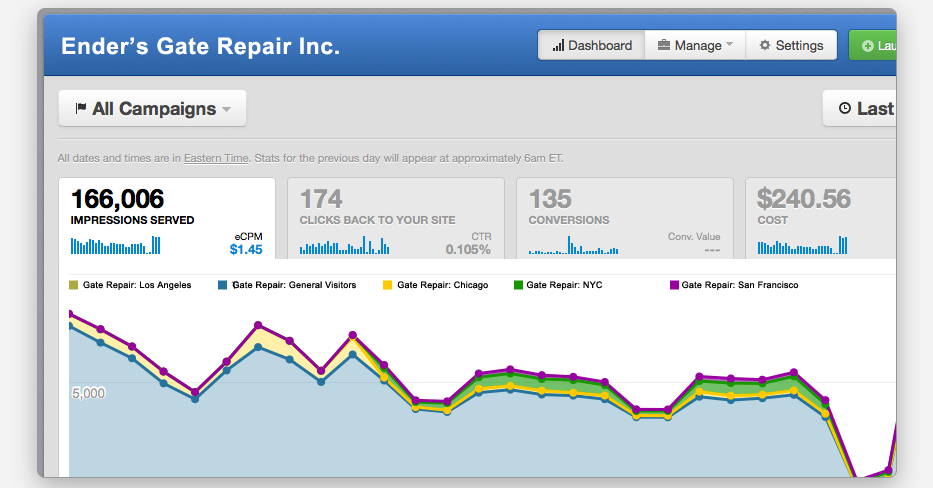
You are losing leads and sales every time a visitor to your website abandons a form or shopping cart. You can actually bring some of these potential customers back through the use of FBX.
FBX is Facebook Exchange, a way to retarget visitors to your website with ads when they return to Facebook. While it’s great for abandoned shopping carts (think Amazon), it’s also another way to target relevant users with your content, products and services whom you may have otherwise missed through other targeting methods.
For example, let’s say you are announcing a new product. You’ll likely create an ad that targets the following groups of people:
- Fans
- Email List Subscribers
- Non-Fans Based on Interests
- Non-Fans Based on Lookalike Audiences
After all of this, you may still be missing a very relevant group: Those who have visited your website but don’t qualify under the targeting above.
Your Goal for 2014: Experiment with FBX! You need to use an approved third party to run FBX ads. Here’s more information on how you can get a jump start with Perfect Audience (including some free ads!).
5. Create a Saved Target Group in Power Editor
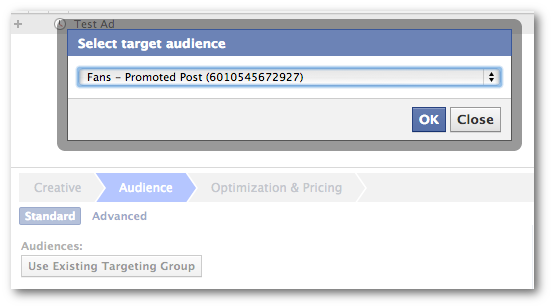
People often ask me why I continue to use Power Editor instead of the self-serve ad tool for creating ads. After all, the self-serve ad tool has been improved significantly lately, and the feature set is getting closer and closer to what is available within Power Editor.
But here’s a big feature currently missing from the self-serve ad tool. And it can save you a ton of time.
When you create a Saved Target Group, you save all of the targeting you might normally do. For example, when I create campaigns that target non-Fans, I generally create five different ads that target different groups of people. This could waste a ton of time if I did all of that manually.
With Saved Target Groups, I create this once and then simply select it when creating my ads. The info is then pre filled for me.
Your Goal for 2014: Create at least one Saved Target Group based on the audience of non-Fans you target most often — preferably a group that requires the most time to enter targeting.
6. Try oCPM (Again)
Lately, I’ve received more and more messages from people complaining about their ads not running or not being able to reach daily budgets. A big reason for this is that they are using CPM or CPC.
People are scared off by Optimized CPM because the price per thousand impressions tends to be significantly higher than the other two. But I find repeatedly that using it is most efficient when it comes to cost per page like, registration and sale.
It’s a matter of knowing what metrics actually matter. Things like CPM, CPC and CTR really don’t. You want to know how much it costs to get your desired action.
And oCPM is optimized to reach the people most likely to perform your desired action. You pay more to reach that prime group. And you’re likely to find out it’s entirely worth the extra cost per 1,000 impressions.
Your Goal for 2014: Split test oCPM vs. CPC and CPM. When you measure results, focus only on the cost per desired action.
7. Try the Sidebar (Again)
The sidebar is a waste of time and money, right? Facebook users completely ignore that area. It’s just noise.
Well, that’s what we hear repeatedly. But the truth is, you may actually get better results in the sidebar than you think.
Sure, if you were given only one impression, you’d want to invest that impression in the News Feed (either mobile or desktop). You get far fewer clicks on the sidebar.
But there’s a missing factor here: CPM.
You see, I’ve found that it tends to cost me $.08 or less per 1,000 impressions on the sidebar. Comparatively, it costs me about 20 times that in the desktop News Feed and 50 times that on mobile.
So while clicks happen more often in the News Feed, they need to happen at least 20-50 times more often to make it worthwhile. And of course, we don’t care necessarily about clicks, but of desired actions (likes, link clicks, registrations and sales).
Also, while you shouldn’t hit people repeatedly in the News Feed, you can do this in the sidebar. It’s great for awareness.
Your Goal for 2014: Try the sidebar again. Compare your Cost Per Desired Action results to mobile and desktop News Feeds over a large sample size.
8. Track Conversions of an Ad
If you send users to your website to fill out a form, subscribe to your email list or buy something and you aren’t tracking conversions, you’re guessing. And it can be a colossal waste of time.
When using conversion tracking, you can also combine these results withFacebook ad reports to help discover how to get the lowest cost per conversion. Is it in the News Feed? Is it when targeting women? Is it when targeting users in Australia? Is it when targeting users aged 35-44?
If you don’t use conversion tracking, you can use Google Analytics to tell you whether your ad led to a conversion. But you’ll never be able to break it down in this manner.
Your Goal for 2014: Run an ad that promotes a desired offsite conversion. Set up conversion tracking and use the ad reports to help you optimize!
9. Create an Online Offer

If you are a business on Facebook, you sell something. It could be a product or a service, but you sell something.
If you’re a retail business, Facebook Offers are extremely helpful. Create an Offer from your Facebook page to attract customers to your store.
However, Facebook recently got rid of the ability to create Offers for online businesses. Or so it seemed.
You can actually still do this, though it’s a hidden functionality. I actually tested it out on Black Monday and got a nice 9.5X ROI.
Your Goal for 2014: If you’re an online business, create a Facebook Offer! Make sure it’s a good discount that isn’t available anywhere else. Track the results compared to when simply sharing a link to a product page.
10. Create a Saved Facebook Ad Report
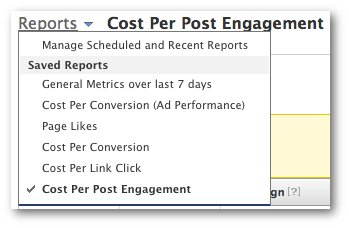
If you aren’t using Facebook Ad Reports, measurement and optimization are incredibly difficult.
I create separate ad reports for campaigns aimed at getting likes, registrations, link clicks and sales. The columns included in them are relevant to those goals. I then save those reports for easy access later.
Your Goal for 2014: Create your own saved report. Start with the type of ad you run most often. Is your goal to get page likes? Create a report with columns for the following:
- Frequency
- Spend
- Likes
- Cost Per Page Like
Then save it! You can also have it emailed to you on a periodic basis.
11. Confirm Referral Traffic in Google Analytics
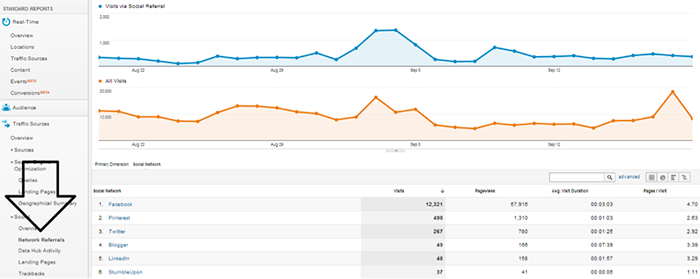
It’s good to know the link clicks that resulted from your Facebook posts and ads. But it’s always good to confirm those numbers through the use of Google Analytics.
I use Google Analytics to give me an idea of referral traffic from specific posts (using URL parameters), but I also monitor the total Facebook referrals as well as revenue generated from Facebook.
Your Goal for 2014: Read this post about combining Facebook and Google Analytics to start setting up your own reports!
12. Download Your Post Level Export
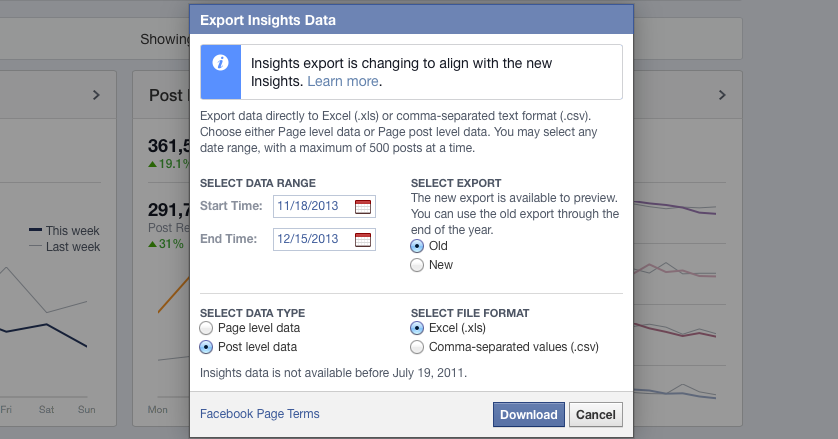
There’s some pretty good info in Facebook’s web Insights. The format has been completely overhauled and is actually quite useful. But it’s still top level.
The vast majority of marketers have never touched an export file. And that’s a shame.
Specifically within the post level export, you can get access to information that isn’t available elsewhere.
It’s overwhelming. It’s a lot of data without any pretty pictures. But it’s worth it.
Your Goal for 2014: Download your post level export for a 150 day period ending two weeks ago. Start poking around. Take a look at what works and what doesn’t. And if you are dangerous with spreadsheets, start spotting trends using averages and charts.
13. Compare Link Click Data Based on Post Type
Marketers obsess so much over the Reach metric that it prevents them from focusing on what actually matters. A prime example is when sharing links where the goal is to drive website traffic.
Is Reach important in this case? To a point, but the most important thing is that you get link clicks.
So, sure, you could create a text update with an ugly URL in it. Or you could attach a URL to the description of a big photo. In either case, you may get higher Reach or more general engagement (in other words, a lot of useless photo clicks).
But are you getting more link clicks? I won’t say for sure (link shares get me more link clicks) since it’s different from person to person. But cast aside your assumptions and try it out.
Something else to consider: It tends to be dangerous to do anything that goes against what Facebook intended. If you’re going to share a link, share a link. It’s not a text update. It’s not a photo.
Why? First of all is the matter of virality. If a photo with a link in the description is shared, it looks different when seen from the second or third degree. The link is far less prominent.
But also, think about Graph Search. Facebook will eventually provide the ability to search for posts. So imagine if, for example, someone is searching for “Links about changes to Facebook image sizes.” Do you think photos or text updates will come up in the results? Nope. Just links.
Your Goal for 2014: Run your own test. Try running link shares the old fashioned way for two weeks. Try it then with text updates. And then try it with photos. When you’re done, compare the direct traffic that resulted (not engagement or reach).
14. Define Success Without Using Reach
This is a simple request. I find that Reach is the most overused word in our marketing vocabulary. I’ve wasted several articles on the topic (try here, here, here and here), and I’m frankly tired of it.
It’s not that Reach is completely worthless. It has some value. But it isn’t worth anywhere near the time we give it.
Your Goal for 2014: The next time someone complains to you about your Reach being down, ask them two simple questions:
- How have the other metrics like sales, leads and website referrals been?
- What is your Reach on Twitter?
Then sit back and enjoy the response.